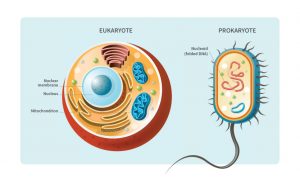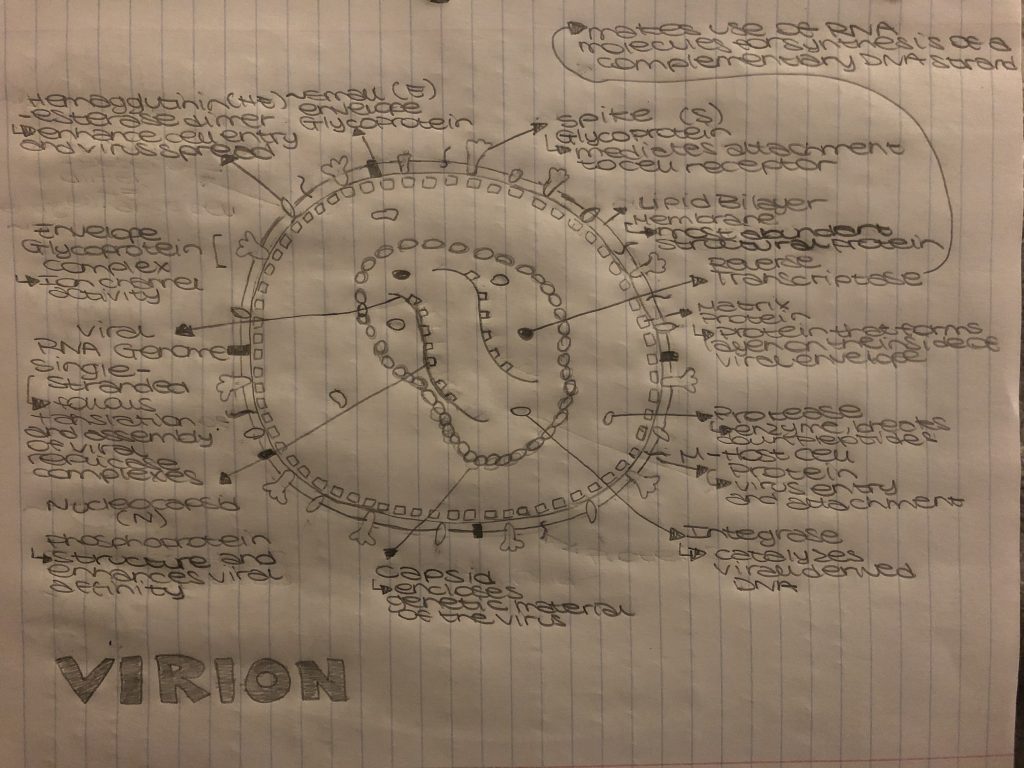Throughout the semester, I have learned a lot about cell biology. I believe it is a fundamental class that we all need to take regardless of major because it elaborately explains human and plant cells. Some topics that we went over were living and non-living organisms, cell metabolism, cell communication, cell division, extracellular matrix, and biological molecules. I realized cell biology had a deeper connection to health care when we started to learn about viruses and SARS-COV-2. This topic stood out to me because SARS-COV-2 is the virus that the world is currently battling, and I was able to understand its components and functions.

SARS-COV-2
Viruses are small parasites that reproduce and occupy host body. They are 8 times smaller than a E. coli, and have a diameter of approximately 125 nanometers (Vidyasagar, 2016). A typical virus has either a DNA or RNA molecule, can either be double segmented or single segmented, positive-sense or negative-sense, linear or circular, segmented or not segmented viral genomes. Bacteriophages usually have double-stranded DNA whiles most plants viruses and human viruses have single stranded RNA genomes found in the capsid just like SARS-COV-2. SARS-COV-2 has the largest non-segmented positive-sense single stranded RNA genome that enables it to act as an mRNA which assembles and translates the viral replicase polyproteins. Due to the RNA genome, it also has helically symmetrical phosphorylated nucleocapsid structural proteins that reside in the envelope.
The enzymes attached to the cell membrane of most organs’ cells but mainly found in the lungs, heart, kidneys, intestines, and arteries are called the angiotensin-converting enzymes 2, also known as ACE 2. The ACE2 is a transmembrane protein that contains zinc, N-terminal, and C-terminal catalytic domains that end with a single transmembrane helix (Angiotensin-converting enzyme 2, 2020). The function of this molecule is to enzymatically cleave the C-terminal from the angiotensin 2, by dilating the narrow blood vessels, ACE2 catalyzes angiotensin II into angiotensin. The S1 spike protein of the SARS-COV-2 virus binds to the human angiotensin-converting enzyme 2 (ACE2) receptor molecules and uses them as the main entry point in human cells; this process occurs in the S protein domain (Angiotensin-converting enzyme 2, 2020). Before entry, the type II transmembrane serine protease, located on the surface of the host cells, activates the receptor attached to the S protein, which allows the virus to enter (Astuti and Ysrafil, 2020). The binding between the S and the ACE2 protein results in two cellular processes called endocytosis, in which the protein surrounded by cell membrane forms a vesicle upon release into the cells, and translocation, the mechanism of protein sorting; the release of both virus and protein occurs in the endosomes (Angiotensin-converting enzyme 2, 2020). Immediately after the release into the host cell, the genomic material of the virus is released in the cytoplasm and translated into protein in the nuclei; this forces the cell to produce and spread copies infecting other cells (Astuti and Ysrafil, 2020).
Due to the translation of the replicase gene from the genome, a replicase transcriptase complex is assembled for RNA synthesis and manages the RNA replication and transcription. Subsequently, the RNA synthesis translates and assembles as the replicase complexes (Fehr and Perlman, 2015). Out of the five structural proteins, the S, M, and E are translated and transported through the secretory pathway into the endoplasmic reticulum. Then these proteins are relocated to the endoplasmic reticulum Golgi intermediate compartment. The genome, bounded to the N structural protein, assembles in the cytoplasm and is localized in the endoplasmic reticulum-Golgi intermediate compartments to form mature virions. This process increases the affinity of the genome. The E structural protein forms protein-lipid pores that enable the transport of ion, but since the M protein is unable to function alone in the formation of the virion, the E protein assists the M protein in the formation of envelopes of the virus. However, the S structural protein is not essential for assembly; instead, its function is to traffic to the endoplasmic reticulum Golgi intermediate compartments and alongside the E protein, it improves host cell attachment. Hemagglutinin assists the S protein improve host cell entry and spreads disease. The binding of the M protein to the nucleocapsid completes the structural assembly of the virus. The assembled virions are then transported in vesicles to the surface of the infected host cells and released via exocytosis, the fusion of the cell membrane with the vacuole membrane, to another host cell (Fehr and Perlman, 2015). The spike is what gives the virus its surface structure and it also improve host cell attachment. The M protein has 3 transmembrane domains.
The transmission of the virus from human to human occurs primarily through cough and sneeze droplets within 6 ft. This virus is also able to transfer through contaminated surfaces (Severe acute respiratory syndrome coronavirus 2, 2020). Upon contamination, the primary cells infected by the SARS-COV-2 are the epithelial cells located within the respiratory tract and lungs. The entry of the virus triggers the host’s immune system, and in response, the immune system releases macrophages and dendritic cells, causing them to be amongst the first cells to be attacked by the virus (Astuti and Ysrafil, 2020). Due to this infection, the symptoms include diarrhea, stomach cramps, respiratory pneumonia, coughing, blood pressure changes, along with severe lung injuries. Two other symptoms that are out of the ordinary are loss of smell and taste. On April 12th of 2020, 68% COVID-19 confirmed positive cases had a loss of smell and taste, even though the loss of smell and taste was profound their recovery was relatively fast, they stated that this was normal due to the virus being respiratory (Yan et al., 2020).
References
En.wikipedia.org. 2020. Angiotensin-Converting Enzyme 2. [online] Available at: <https://en.wikipedia.org/wiki/Angiotensin-converting_enzyme_2> [Accessed 26 April 2020].
Astuti, I. and Ysrafil, 2020. Severe Acute Respiratory Syndrome Coronavirus 2 (SARS-CoV-2): An overview of viral structure and host response. Diabetes & Metabolic Syndrome: Clinical Research & Reviews, 14(4), pp.407-412.
Fehr, A. and Perlman, S., 2015. Coronaviruses: An Overview of Their Replication and Pathogenesis. Coronaviruses, pp.1-23.
En.wikipedia.org. 2020. Severe Acute Respiratory Syndrome Coronavirus 2. [online] Available at: <https://en.wikipedia.org/wiki/Severe_acute_respiratory_syndrome_coronavirus_2#Virology> [Accessed April 26th 2020].
Yan, C., Faraji, F., Prajapati, D., Boone, C. and DeConde, A., 2020. Association of chemosensory dysfunction and Covid-19 in patients presenting with influenza-like symptoms. International Forum of Allergy & Rhinology,
